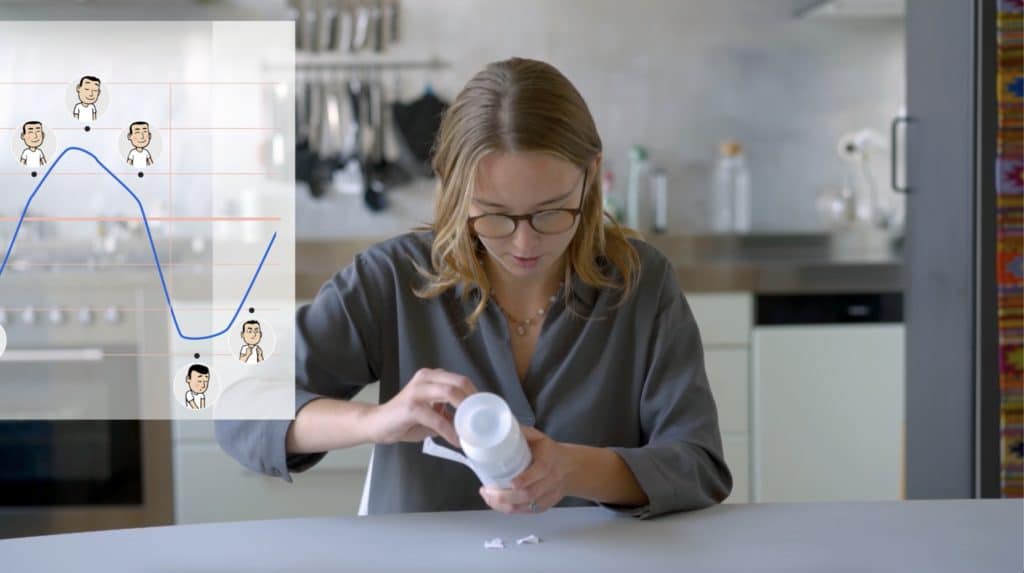Even using a detergent to wash your clothes could easily involve 30+ connected micro-emotions!
From generic to a little bit of genius
This is vitally important when product or service sectors have broadly similar offerings. People are right to expect a certain level of quality which all providers must attain – so how can they go beyond that to create a unique and memorable customer experience? Simple: by triggering as many positive micro-emotions as possible throughout the customer’s interaction with the product or service. It means adding little sparks to the experience that create positive associations in their mind.
Micro-emotions have four fundamental sources:
- Senses – the aesthetic experience through the senses
- Meaning – the affective associations the product evokes
- Interaction – how well the product can be used and understood
- Enabler – what the product helps the user to accomplish, and which needs it addresses
Each of these experiences are subtle and short-lived, but together they have a decisive impact on people’s evaluation of a product or service. And only when the overall evaluation is positive are people likely to buy your product or use your service again and become regular customers. Knowing that it takes seven purchases to become a loyal buyer, it is a challenge for many companies to offer such an outstanding user experience.
Author and influencer Steven Van Belleghem identifies three key areas where such incidental emotional responses can have a big cumulative overall effect on the customer’s impression:
- Empathy
How can you add a human touch to the customer experience? This is something that a computer could never do – to be able to communicate on a very human level by understanding the subtle and fluid interaction between provider and customer - Positive intent
People don’t expect perfection in a product or service. But they do want to feel you have done your best to give them what they need. So, even if something is not quite right, they will be satisfied if it is clear you went out of your way to try and deliver a good experience - Serendipity
This refers to a moment of magic delivered during in the CX, something unexpected that makes the customer go “Wow”, “Ooh” or “Ahh!”. Since people can find out so much online these days before experiencing a product or service, creating such surprises is more difficult than ever.
64% of consumers say they are more likely to recommend a brand to others if it offers simpler experiences and communications.
– Steven van Belleghem
Real life examples
Through research carried out at Emotion Studio, we have identified real life examples of these types of interaction which add a more emotional and human aspect to the customer experience. From our research we have also added a fourth key area where micro-emotions can play a part: simplicity.
A good example of empathy in product design is being able to anticipate and appreciate the precise situation a customer will experience the product in. A well-known brand of detergent demonstrates empathy by making its packaging for laundry pods small and compact because it knows people want to maintain a neat and tidy house – especially where storage options are limited. They also make it humidity-resistant because the pack is likely to be kept in a bathroom or laundry room where moisture is present. And they add a window to the packaging to make it easy to see how many detergent blocks are left so the user doesn’t run out unexpectedly.
As an example of positive intent, the laundry pods packaging makes it easy for the user to separate different elements of the packaging for disposal. The customer does not necessarily expect a 100% sustainable solution, but at least the manufacturer was thinking in a helpful way to make it easier to recycle.
On the other hand, the kudos of positive intent can be reversed by design elements that inspire negative emotions. Detergent packs, for example, that are difficult to open can make the user feel stupid (not to mention extremely frustrated).
When it comes to serendipity, surprises can be big or small – and they can happen anywhere along the customer journey. Examples we have uncovered include fragrance cards in detergent packs, but it could also be as simple as giving value for money and exceeding expectations: a customer buys a product in the supermarket, takes it home and is pleasantly surprised to find more inside than they were counting on. And, at the end of the customer journey, packaging that is easy to dispose of can give a final “Aah, that’s thoughtful” moment.
Then there’s simplicity. That means keeping everything simple – from the way instructions are written to the way the product is used – and fitting in with a customer’s received behaviour. In the case of soap powder, this could apply to ease of opening, use, dosing, and disposal.
So, for example, the detergent manufacturer needs to explain clearly how to place laundry pods in the washing machine or how to open a pack with a child lock. And it means giving information at the right time: so, as the customer is taking a pod out of the pack, remind them at that moment of the dosing instructions. Presenting the product in an ordered and structured way helps give people an overview of what’s going on and a feeling of being in control.

Mapping micro-emotions
As you can see, managing micro-emotions can be a very powerful marketing tool and an essential element of the product (or service) design process. Retrospectively you can also test existing products to assess how well they are performing at this micro level – and how they could be delivering a better customer experience. Emotion Studio has developed unique tools and techniques to map micro-emotions in order to design more successful products and services. Find out more.

Want to know more about micro-emotions?
Don’t hesitate to contact us for any inquiries!
